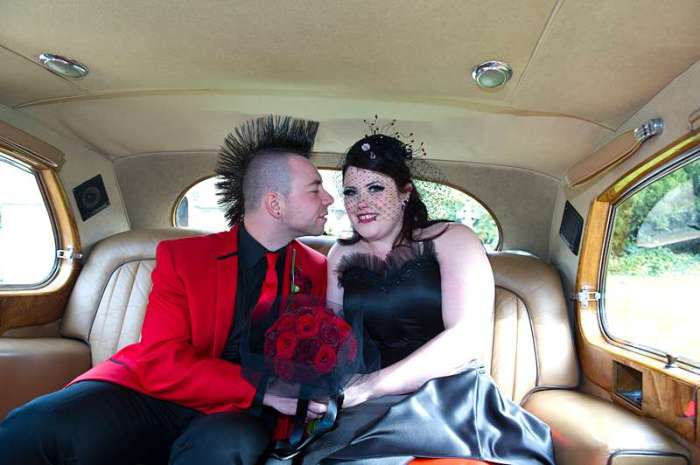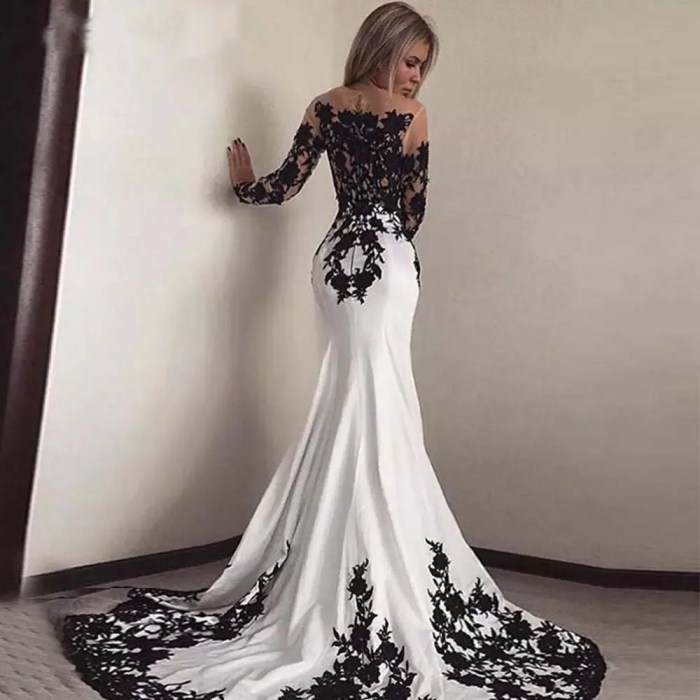Dyeing a Wedding Dress Black: A Transformative Process

Source: co.uk
Dye a wedding dress black – Transforming a pristine white wedding dress into a striking black garment is a bold statement, laden with symbolic weight and personal significance. This process, while seemingly simple, involves a careful consideration of various factors, from the emotional reasons behind the decision to the practical aspects of dyeing and aftercare. This article delves into the intricacies of dyeing a wedding dress black, exploring the motivations, methods, color considerations, and ethical implications involved.
Reasons for Dyeing a Wedding Dress Black
The decision to dye a wedding dress black is rarely impulsive. It often stems from a profound emotional experience or a desire to reinterpret the garment’s symbolic meaning. The stark contrast between the traditional white, representing purity and innocence, and black, often associated with mourning, power, or rebellion, creates a powerful visual metaphor.
Emotionally, this choice might reflect a significant life change, a period of mourning, or a desire to reclaim agency after a challenging experience. For some, it’s about transforming a painful memory into a symbol of resilience. Others might view it as a way to repurpose a cherished item, preventing it from gathering dust while preserving its sentimental value. One could imagine a bride, after a difficult divorce, choosing to dye her dress black as a symbolic act of moving on, embracing a new chapter, and reclaiming her strength.
Culturally, the interpretation of this transformation varies. In some cultures, black is associated with elegance and sophistication, while in others, it holds more somber connotations. The act of dyeing itself could be viewed as a reclamation of the garment, a personal act of artistic expression, or a statement of defiance against societal expectations.
Methods for Dyeing a Wedding Dress Black

Source: etsystatic.com
Several methods exist for dyeing a wedding dress black, each with its own advantages and disadvantages. The choice depends on factors such as the fabric type (silk, satin, lace), the desired shade of black, and the level of expertise. Generally, fabric dyes are preferred over other methods for even color saturation and longevity.
Pre-treating the dress is crucial before dyeing. This involves carefully checking for any stains or embellishments that might react negatively to the dye. Any loose threads or embellishments should be secured. The dress should be thoroughly cleaned to remove any dirt or oils that may interfere with the dye’s absorption. A test patch on a hidden area is highly recommended to check for color consistency and fabric reaction.
A step-by-step guide using a fiber reactive dye, suitable for most wedding dress fabrics, is Artikeld below:
| Materials | Steps | Precautions | Potential Issues |
|---|---|---|---|
| Fiber reactive dye (black), Dye fixative, Rubber gloves, Protective eyewear, Large container (stainless steel or plastic), Measuring cups and spoons, Stirring utensil, Washing machine | 1. Prepare the dye bath according to the manufacturer’s instructions. 2. Submerge the dress completely in the dye bath. 3. Stir gently to ensure even dye distribution. 4. Allow the dress to soak for the recommended time (usually several hours). 5. Rinse thoroughly with cold water until the water runs clear. 6. Add dye fixative and soak according to the instructions. 7. Machine wash separately with a color-safe detergent. | Always wear gloves and eye protection. Work in a well-ventilated area. Avoid direct skin contact with the dye. Follow manufacturer’s instructions precisely. | Uneven dye absorption, Color fading, Damage to delicate fabrics, Dye stains on surfaces. |
Color Considerations and Results

Source: rosesandrings.com
The final shade of black achieved depends on several factors, including the original fabric color, the type of dye used, and the dyeing process. Even with the same dye, different fabrics may yield slightly varying shades. Achieving a deep, rich black might require multiple dyeing sessions.
- On silk, a deep, almost velvety black can be achieved, with subtle sheen variations depending on the weave.
- Satin might yield a slightly lighter black, with a more pronounced sheen.
- Lace can produce a black with intricate detail, with the dye potentially pooling slightly in the more textured areas.
- Tulle might result in a softer, less intense black.
The dyeing process can slightly alter the fabric’s texture and feel. Some fabrics might feel slightly stiffer or less fluid after dyeing, while others may remain largely unchanged. It’s crucial to choose a dye and method appropriate for the fabric to minimize any negative impact on texture.
Aftercare and Preservation, Dye a wedding dress black
Proper aftercare is essential to maintain the color and longevity of the black-dyed wedding dress. Gentle hand washing with a color-safe detergent is recommended to avoid color fading or damage to the fabric. Avoid harsh chemicals or abrasive cleaners.
- Always hand-wash or use a gentle cycle in a washing machine with cold water and a color-safe detergent.
- Avoid using bleach or harsh chemicals.
- Air dry the dress flat to prevent stretching or damage.
- Store the dress in a cool, dark, and dry place, away from direct sunlight or moisture.
- Consider using acid-free tissue paper to protect the fabric from wrinkles.
- Store in a breathable garment bag to prevent dust and damage.
Potential issues after dyeing might include color fading or uneven color distribution. Addressing these issues might involve re-dyeing parts of the dress or using a color-restoring treatment.
Dyeing a wedding dress black is a bold choice, often symbolizing a transformation or a new beginning. The minimalist elegance of Carolyn Bessette-Kennedy’s iconic wedding dress, a style you can find a replica of at carolyn bessette wedding dress replica , makes one wonder how such a simple design might look in a dark hue. Ultimately, dyeing a dress black is a personal statement, regardless of the original design’s inspiration.
Ethical and Environmental Considerations
The environmental impact of fabric dyeing is significant, particularly when using synthetic dyes. These dyes can contain harmful chemicals that pollute water sources. Natural dyes, while often more expensive and less vibrant, offer a more sustainable alternative.
| Dye Type | Environmental Impact | Cost | Color Vibrancy |
|---|---|---|---|
| Synthetic | High; potential water pollution from chemical runoff. | Generally lower | Generally higher |
| Natural (e.g., plant-based) | Lower; biodegradable and less likely to pollute water. | Generally higher | Generally lower; wider range of colors possible |
Ethical considerations extend to sourcing materials responsibly and ensuring the safe disposal of dye waste. Choosing dyes and materials from reputable suppliers who prioritize sustainability is crucial. Exploring options like using pre-owned fabrics or employing upcycling techniques can further minimize the environmental impact.
FAQ Corner: Dye A Wedding Dress Black
Can I dye a silk wedding dress black?
Silk can be dyed, but it requires a gentle approach. Use a fiber-reactive dye designed for delicate fabrics and follow the instructions carefully to avoid damage.
How long does the dyeing process take?
The dyeing time varies depending on the method and dye used, but it can range from a few hours to overnight.
Will the dye bleed after washing?
To minimize bleeding, use a color-fast dye and wash the dress separately in cold water with a color-safe detergent. A final rinse with white vinegar can help set the color.
What if I don’t like the result?
Unfortunately, reversing the dyeing process is difficult. It’s crucial to test the dye on a hidden area of the dress first to ensure you’re happy with the color.
